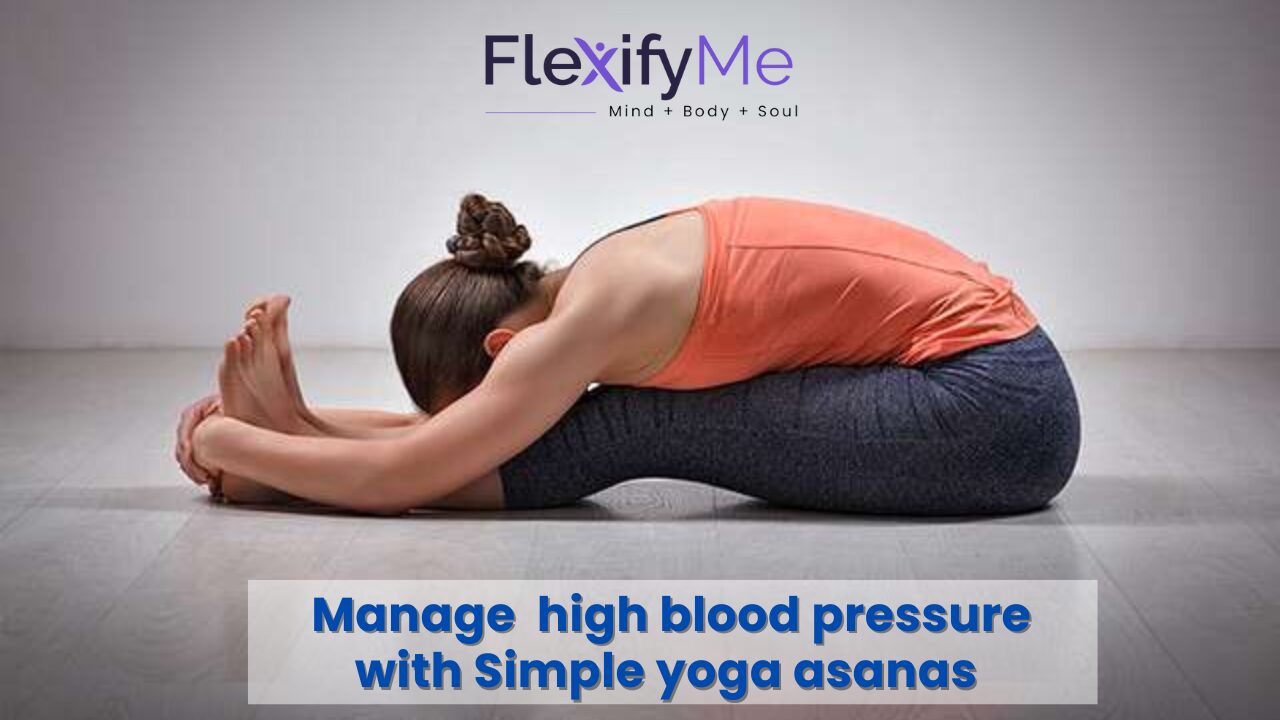We all have heard of hypertension or high blood pressure. Around 1.28 billion adults aged between 30 and 79 years worldwide have high blood pressure, also known as hypertension. It is among the most common health conditions. While some people can understand they have it, many remain asymptomatic. Many people tend to ignore high blood pressure since it is a common condition. But, it is not the right thing to do. The problem, which seems very common to you, can lead to serious health conditions like heart attacks and strokes.
As individuals, it is your responsibility to keep your health in check. By indulging in a healthy way of life, you can take a step forward in reducing the risk of such severe health conditions, caused due to high blood pressure. Besides making the right food choices, you can include yoga for high blood pressure in your daily routine. Yoga has a multitude of benefits and practising yoga daily can cure many health hazards, including hypertension.
There are various yoga poses for high blood pressure that impact the flexibility of the arteries and improve blood circulation in the body, thereby reducing hypertension. So, if you want to improve your life and reduce your hypertension, here are some yoga asanas that you can perform.
Yoga Poses For High Blood Pressure

Below are some of the most effective yoga poses to reduce blood pressure.
Shishuasana (Child’s Pose)
This is one of the most basic yoga poses and also an effective one. You can take this pose as a warm-up pose or a resting pose for a back bend. This exercise is a great way to relax your neck, spine and shoulders. It is also a great yoga for high blood pressure. If you’re a beginner, then this is just the right yoga pose for you. To do this pose, you have to:
- Sit in your heels.
- Stretch forward with your hips on the heels and lower your forehead to the floor.
- Hold your arms across the body and your hands on the floor.
- Your palms will face up. (if you find this position to be uncomfortable, you can lay one fist on top of another and rest your forehead on them)
- Press your chest toward the thighs slowly.
- Hold the position.
- Then, slowly rise to sit on your heels, loosening and relaxing each vertebra.
Padmasana (Lotus Pose)
The best cure for hypertension is to relax. And if you perform padmasana, you have found your way. This pose helps you calm your mind and nerves, thereby reducing blood pressure to a normal level. Following are the steps to do the lotus pose:
- Be seated on the floor.
- Expand your legs firmly in front of you.
- Bend the right leg at the knee.
- Keep your right foot on your left thigh using your hands.
- Now bend the left leg at the knee.
- Now, using your hands, bring your left foot to your right thigh.
- At this point, both feet should be directed towards your navel. Ensure the soles of your feet are turned upward.
- Extend your arms so that they can rest upon your knees.
- Sit upright while maintaining the posture.
Shavasana (Corpse Pose)
Stress and anxiety are the highlighted causes of high blood pressure. It is thus important to keep your mind calm. Of course, life will throw various unforeseen circumstances, and your immediate response to them will be to freak out. But, if you start practising shavasana, you can see the change in yourself, gradually. This yoga pose is usually performed toward the end of all rigorous exercises, which will help you relax. Nobody can be more relaxed than a corpse, and that’s what this yoga pose resembles. Relaxing your mind while lying in a relaxed position is one of the best yoga techniques for hypertension. And Shavasana is all about that. You have to:
- Lie on your back on the yoga mat or floor.
- Spread your legs in a relaxed position.
- Maintain a comfortable pose, with both your arms on each side of the body.
- Close your eyes and concentrate on each breath, being conscious about your chest and belly rising and falling.
- Do it for 10-20 seconds or even a minute if you like.
Vajrasana (Diamond Pose)
Vajrasan is a fundamental and effective pose that serves as a foundation for many other yoga poses. This pose helps improve sleep, reduce stress, control blood sugar levels, strengthen muscles and manage hypertension. Following are the steps to practise vajrasana:
- Sit down on the floor.
- Bring your knees close together.
- Ensure your feet are a bit apart.
- Sit back between your calves.
- Press your feet as much as you can toward your buttocks.
- Keep your back straight while doing it.
- Stretch your hands in front so that you can cover your knees.
- Maintain the pose for 2 minutes.
- Extend the time gradually as you practise the pose.
Bhujangasan (Cobra Pose)
Commonly known as cobra pose, bhujangasana promotes blood circulation throughout your body. If blood circulation is stable, blood pressure levels will also be normal, resulting in a lower chance of hypertension. Bhujangasana also helps to relax the facial muscles, back, neck, shoulders, hands and spine. To do bujangasana, you have to:
- Lie on your stomach in a resting position.
- Cross your hands in front of you so that you can rest your head on them.
- Now, move your legs close together and lay your forehead on the ground.
- Curl your arms at the elbow and place your hands close to the shoulders.
- Gently lift your elbows from the floor and inhale while doing it. Also, raise your forehead and push your chin out.
- Raise your torso from the floor.
- Ensure your stomach is pressed to the floor at this point.
- Continue inhaling and exhaling until your body feels completely relaxed.
If you have body weakness, sign up for free. Find your weaknesses with AI-enabled analysis and let yoga experts find you a remedy.
Dhanurasana (Bow Pose)
Also known as the bow pose, dhanurasana is an extension of bhujangasana. This is an excellent pose for stretching the upper and lower body. One of the best yoga techniques for hypertension is stretching, which is exactly what dhanurasana offers. Furthermore, the yoga pose helps to build up muscles and ease international problems. Below are the steps to perform dhanurasana:
- Lie flat on your stomach.
- Make sure your forehead rests on the floor, and your legs are close together.
- Twist your legs toward the knees and raise your feet behind you.
- Expand your arms backwards and hold your ankles.
- Inhale and lift your forehead from the floor while lifting your thighs.
- Your body should be arching in an upward direction.
- Hold the position for about 10 seconds if you’ve just started practising this yoga pose.
- Once you’re accustomed to it, increase the time to up to 30 seconds or more.
Adho Mukha Svanasana (Downward-Facing Dog Pose)
This may seem to be a complicated pose if you’re just starting with yoga. But, in high blood pressure yoga routines, this pose has been quite effective. You can improve balance and flexibility by practising this yoga pose. At the same time, the pose improves heart and muscle functioning, thereby improving circulation and reducing blood pressure to a normal level. To do adho mukha svasana, you have to:
- Kneel on the floor, keeping your knees hip-width apart.
- Lean forward and place both of your hands on the floor.
- Make sure your hands are straight and under your shoulders.
- Slide back with both feet, keeping your arms and shoulders aligned. The pose should resemble the alphabet A, or you should look like a hill standing on the floor.
- Maintain this pose for about 5 to 10 breaths before going back to the starting position.
Pranayam
Pranayam is a widely-known breathing exercise in yoga. People perform pranayam to bring their breathing patterns under control. Pranayama helps to regulate blood pressure and other health concerns. This yoga pose can be classified into several categories including deep breathing, slow breathing, exhalation-focused breathing, quick breathing and forceful breathing. Each of these breathing exercises has its own benefits. But, the focus of all these breathing exercises is the same, i.e. to promote relaxation and serenity in both mind and body. To do pranayam, you need to:
- Get up early in the morning. This provides a terrific start to the day and enhances your energy so that you can be more active than you usually are.
- To begin the exercise, you have to first sit in the lotus pose.
- Choose a peaceful place and practise different variations of breathing.
- For maximum benefit, you have to concentrate solely on your breathing.
Conclusion
To get relief from high blood pressure, you can consider practising these yoga positions. While some of these positions are absolutely simple, others may seem a little complex initially. But with practice, you can master these moves and reap all their benefits.
For your posture alignment issues or any kind of pain in the body, you can book a demo and get the necessary assistance through natural remedies.


